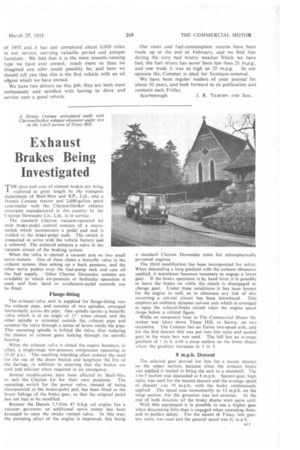Exhaust Brakes Being Investigated
Page 37

If you've noticed an error in this article please click here to report it so we can fix it.
THE pros and cons of exhaust brakes are being explored at great length by the transport department of Shell-Mex and B.P., Ltd., and a Dennis Centaur tractor and 2,000-gallon spirit semi-trailer with the Clayton-Oetiker exhaust obturator manufactured in this country by the
Clayton Dewandre Co.. Ltd., is in service. •
The standard Clayton vacuum-operated kit with brake-pedal control consists of a microswitch which incorporates a pedal pad and is welded to the brake-pedal stalk. The switch is connected in series with the vehicle battery and a solenoid. The solenoid actuates a valve in the vacuum circuit of the braking system.
When the valve is opened a vacuum acts on two small servo motors. One of these closes a butterfly valve in the exhaust system, thus setting up a back pressure, and the other servo pushes over the fuel-pump rack and cuts off the fuel supply. Other Clayton Dewandre systems are available in which air-pressure or hydraulic operation is used, and foot. hand or accelerator-pedal controls can be fitted.
Flange-fitting
The exhaust-valve unit is supplied for flange-fitting into the exhaust pipe, and consists of two spindles, arranged horizontally across the pipe. One spindle carries a butterfly valve which is at an angle of 15° when closed, and the other spindle is extended outside the exhaust pipe and actuates the valve through a series of levers inside the pipe. This operating spindle is behind the valve, thus reducing the chance of exhaust gases leaking through the spindle bearing.
When the exhaust valve is closed the engine becomes in effect, a single-stage low-pressure compressor operating at 35-45 p.s.i. The resulting retarding effect reduces the need for the use of the drum brakes and lengthens the life of the facings, in addition to ensuring. that the brakes are cool had efficient when required in an emergency.
Several modifications have been effected by Shell-Mex to suit the Clayton kit for their own purposes. The operating switch for the power valve, instead of being incorporated in the brake-pedal pad, has been fitted to the lower linkage of the brake gear, so that the original pedal has not had to be modified.
Because the Dennis 5.5-litre 87 b.h.p. oil engine has a vacuum governor, an additional servo motor has been arranged to open the intake venturi valve. In this way, the pumping effect of the engine is improved, this being
a standard Clayton Dewandre extra for' atmospherically governed engines.
The third modification has been incorporated for safety. When descending a long gradient with the exhaust obturator applied, it sometimes becomes necessary to engage a lower gear. If the brake operation is by hand lever it is possible Lo leave the brake on while the, clutch is disengaged to change gear. Under these conditions it has been known for the engine to stall, so to eliminate any risk of this occurring a cut-out circuit has been introduced. This employs an ordinary dynamo cut-out unit which is arranged to open the exhaust-brake circuit when the engine speed drops below a critical figure.
While on temporary loan to The Commercial Motor the tanker was taken down Titsey Hill, in Surrey, on two occasions. The Centaur has an Eaton two-speed axle, and for the first descent this was put into low ratio and second gear in the main box was used. The hill has an average gradient of 1 in 6. with a steep section on the lower slopes where the gradient increases to 1 in 5.
8 m.p.h. Descent
The selected gear proved too low for a steady descent on the upper section, because when the exhaust brake was applied it tended to bring the unit to a standstill. The 1-in-5 section was descended at 8 m.p.h. Second gear, high ratio, was used for the second descent and the average speed of descent was 10 m.p.h., with the brake continuously applied. The speed rose momentarily to 12 m.p.h. on the steep section, but the governor was not overrun. At the end of both descents all the brake drums were quite cold.
With this equipment it is possible to use a higher gear when descending hills than is engaged when ascending them, and in perfect safety. For the ascent of Titsey, low gear, low ratio, was used and the general speed was 4.1. m.p h.
























































































